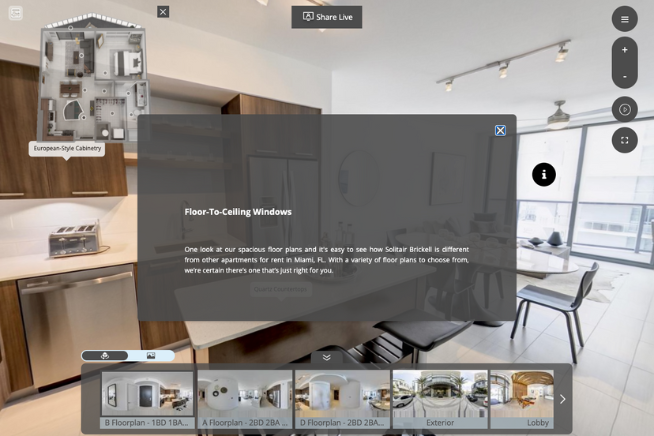Are Self-Service Tools the Future for Multifamily?
Renters have become more comfortable with the idea of self-service tools in the last few years. Self-service tools can consist of self-service...
4 min read
 Kyna Garrett
:
Jul 15, 2019 9:00:00 AM
Kyna Garrett
:
Jul 15, 2019 9:00:00 AM

Decisions, decisions, decisions. That’s what today’s modern apartment renter is facing when they jump online to begin the long, drawn-out apartment hunt.
The thing is: apartment hunting should be fun. It should be easy.
We live in a world of instant gratification, where Amazon 1-Click purchasing and apps at our fingertips are more than expectations. They’re a way of life.
Renters expect a swift and painless apartment search, but the reality is that it still requires scheduling time out of their busy lives, jumping from listing site to listing site and scouring galleries that seem to be buried inside apartment websites.
Today, the modern renter requires an effortless process with all the information they need. One where they don’t necessarily have to set aside time from their 10-hour work day to tour your community.
Multifamily technology has progressed enough to cater to that need. As a multifamily provider, investing in that technology can no longer be a consideration, but rather a requirement in sales and marketing strategies.
What follows is a comprehensive breakdown of multifamily technology empowering the modern renter today.
Virtual tours have been around for quite some time. They’ve come in many varieties, but I’m not referring to photo slideshows or even videos here.
Apartment virtual tours are interactive 360 walk-throughs that allow renters to navigate communities and model units from the comfort of home. It’s simply what it sounds like: a 100% digital representation of an apartment community as you would see it in person. Renters spin the screen in a complete 360 orientation and see an apartment home for exactly what it is.
The challenge in multifamily is that there’s still plenty of education needed around these virtual experiences. What does a virtual tour do for my marketing? Will it bring in leads? Will prospects actually use it?
Among millennials in America, 75% choose to rent an apartment than own a home. Millennials don’t live like their predecessors. Smart buildings, mobile devices, and wireless connections are essentials in their lives. And if apartment communities don’t meet their digital checkboxes, you can consider that option tossed aside.
So yes, millennials and Gen Z do use virtual tours. In fact, they expect to see them on Google listings and on apartment websites.
According to a survey by the U.S. Travel Association, millennials have been considered “work martyrs.”
You read that right. They’re workaholics.
They rarely take time off. They work long hours. And they tend to enjoy it. So when it’s time to upgrade their apartment home or move across town closer to their new office, the apartment hunt becomes a dreaded process that takes too much time.
With apartment virtual tours, they’re able to refine their search and avoid taking too many in-person tours as a result. That’s a good thing for the renter and the property manager. Virtual tours save time and they qualify the renter to avoid meaningless appointments.
Because the modern renter works such long hours, it can also be difficult to schedule appointments during normal business hours. They’re also more likely search online for apartments during late hours of the night.
A virtual tour embedded into an apartment website helps them narrow their decision—not to mention, it’s a great way to capture leads that come in after hours.
A common fear about apartment virtual tours is that they will eventually take over the role of in-person tours. Instead, virtual tours actually allow leasing agents more time to take on other important responsibilities in the leasing process.
Considering that leasing agents and property managers are extremely busy, constantly taking appointments and resolving concerns, virtual tours fill in the gaps when they can’t be readily available.
The apartment search is more than just browsing photography and virtual tours. Renters want to know every aspect of your community—from the amenities offered to the square footage and layout of a unit.
Thankfully, multifamily technology has shifted to upgrade the floor plan experience far beyond standard 2D floor plans.
Enter stacking plans and site maps.
What is an apartment stacking plan?
A stacking plan is a virtual leasing tool that allows renters to browse a community floor by floor and view units available in real-time. As with any apartment search function on a website, prospects typically filter by rooms, bathrooms, price range and square footage. The process begins with an exterior photograph or rendering (if in development) of the community, and the renter journeys through your community where they can browse and apply for a specific apartment home.
What is an apartment site map?
Site maps are visualizations of garden style apartments (communities built in sprawling complexes). Typically, site maps are used inside a stacking plan interface as the starting point. Renters choose a building from the community map, then browse through floors.
Site maps can be interactive or still images.
These tools have become incredibly powerful in the modern apartment hunt. Not only do they engage and offer a sense of transparency, they’re insanely convenient.
If apartment renters don’t have time to schedule an appointment, they certainly don’t have time to figure out how to search your website. That’s why the traditional practice of scrolling through floor plans is dead. Why? Traditional search methods are outdated, inconvenient and don’t offer up enough information about a community.
Renters care about a few key things: location, availability, and price. But location doesn’t just include where a community sits, but also unit location—a key component that is often missing during the search.
When you offer a stacking plan, you’re giving renters all of the information they need right there, including unit location. From the appearance of your building to the interior floor spaces and floor plans of each available apartment, renters have all the information they need in one fell swoop.
The ease of navigation makes the process swift and simple, allowing renters to easily apply or learn more about your community.
It’s not enough anymore to remain stagnant in your multifamily marketing approaches. Far too often, multifamily marketing focuses on branding, while increasing occupancy and keeping renters happy may fall to the wayside.
Catering to renters today and their online behavior leaves you at an extreme competitive advantage. Renters don’t want to be left in the dark anymore. By offering virtual experiences and leasing tools that put them in the driver’s seat, you’re already satisfying that need for instant gratification, thus streamlining the modern apartment search.
Learn more about how to spend your multifamily budget.

Renters have become more comfortable with the idea of self-service tools in the last few years. Self-service tools can consist of self-service...

Once upon a time, multifamily leasing agents would take calls and email inquiries to set up physical tours of their community. They’d greet the...

Virtual tours for apartment homes are one of the latest trends in real estate. These digital experiences have changed the game for lease-ups, renting...